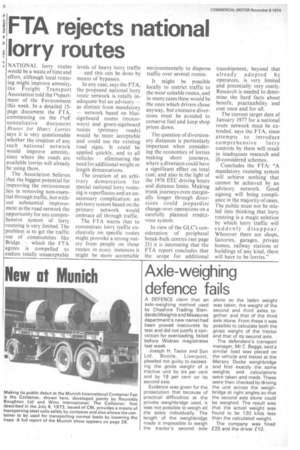FTA rejects national lorry routes
Page 22

If you've noticed an error in this article please click here to report it so we can fix it.
NATIONAL lorry routes would be a waste of time and effort, although local routeing might improve amenity, the Freight Transport • Association told the Department of the Environment this week. In a detailed 15page document the FTA, commenting on the DoE
consultative document Routes .for Heavy Lorries says it is very questionable whether the creation of any such national network would, improve amenity, since where the roads are available lorries will already be using them.
The Association believes that the biggest potential for improving the environment lies in removing non-essential through traffic, but without substantial improvement in the road network the opportunity for any comprehensive system of lorry routeing is very limited. The problem is to get the traffic out of communities like Bridge which the ETA agrees is compelled to endure totally unacceptable levels of heavy lorry traffic and this can be done by means of bypasses.
In any case, says the FTA, the proposed national lorry route network is totally inadequate but an advisory -as distinct from mandatory -network based on bluesignboard routes (motorways) and green-signboard routes (primary roads) would be more acceptable and could use the existing road signs. It could he applied quickly, and to all vehicles -eliminating the need for additional weight or length demarcations.
The creation of an arbitrary demarcation for special national lorry routeing is superfluous and an unnecessary complication: an advisory system based on the primary network would embrace all through traffic.
The FTA warns that to concentrate lorry traffic exclusively on specific routes might provoke a strong outcry from people on those routes; in many instances it might be more acceptable environmentally to disperse traffic over several routes.
It might be possible locally to restrict traffic to the most suitable routes, and in many cases these would be the ones which drivers chose anyway, but excessive diversions must be avoided to conserve fuel and keep shop prices down.
The question of diversionary distances is particularly important when considering the economics of lorries making short journeys, where a diversion could have a significant effect on total cost; and also in the light of the 1976 EEC driving hours and distance limits. Making trunk journeys even marginally longer through diversions could jeopardize change-over operations on a carefully planned rendezvous system.
In view of the GLC's consideration of peripheral break-bulk centres (see page 21) it is interesting that the FTA report concludes that the scope for additional transhipment, beyond that already adopted by operators, is very limited and potentially very costly. Research is needed to determine the hard facts about benefit, practicability and cost once and for all.
The current target date of January 1977 for a national route network must be extended, says the FTA, since attempts to introduce comprehensive lorry controls by them will result in inadequate research and ill-considered schemes.
Concludes the FTA: "A mandatory routeing system will achieve nothing that cannot be achieved by an advisory network. Good signing will bring compliance in the majority of cases. The public must not be misled intO thinking that lorry routeing is a magic solution by which lorry traffic will suddenly disappear. Wherever there are shops, factories, garages, private homes, railway stations or buildings of any kind, there will have to be lorries."




































































































































































































